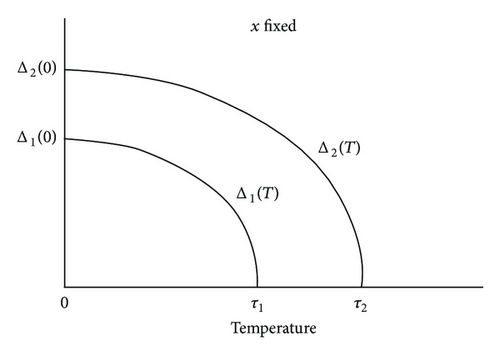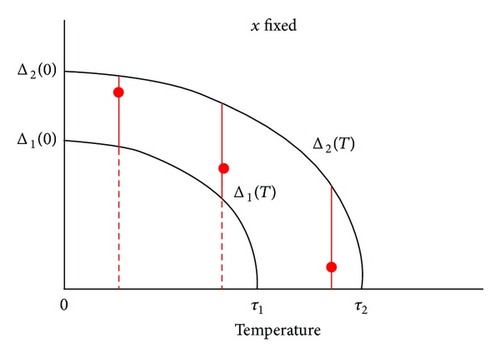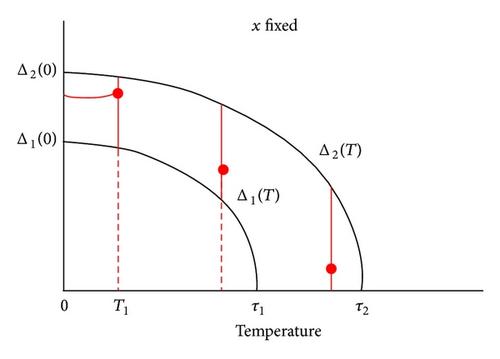The Solution to the BCS Gap Equation for Superconductivity and Its Temperature Dependence
Abstract
From the viewpoint of operator theory, we deal with the temperature dependence of the solution to the BCS gap equation for superconductivity. When the potential is a positive constant, the BCS gap equation reduces to the simple gap equation. We first show that there is a unique nonnegative solution to the simple gap equation, that it is continuous and strictly decreasing, and that it is of class C2 with respect to the temperature. We next deal with the case where the potential is not a constant but a function. When the potential is not a constant, we give another proof of the existence and uniqueness of the solution to the BCS gap equation, and show how the solution varies with the temperature. We finally show that the solution to the BCS gap equation is indeed continuous with respect to both the temperature and the energy under a certain condition when the potential is not a constant.
1. Introduction
We use the unit kB = 1, where kB stands for the Boltzmann constant. Let ωD > 0 and k ∈ ℝ3 stand for the Debye frequency and the wave vector of an electron, respectively. Let h > 0 be Planck’s constant, and set ℏ = h/(2π). Let m > 0 and μ > 0 stand for the electron mass and the chemical potential, respectively. We denote by T(≥0) the absolute temperature, and by x the kinetic energy of an electron minus the chemical potential; that is, x = ℏ2 | k|2/(2m) − μ. Note that 0 < ℏωD ≪ μ.
The integral with respect to ξ in (1) is sometimes replaced by the integral over ℝ3 with respect to the wave vector k. Odeh [3] and Billard and Fano [4] established the existence and uniqueness of the positive solution to the BCS gap equation in the case T = 0. For T ≥ 0, Vansevenant [5] determined the transition temperature (the critical temperature) and showed that there is a unique positive solution to the BCS gap equation. Recently, Frank et al. [6] gave a rigorous analysis of the asymptotic behavior of the transition temperature at weak coupling. Hainzl et al. [7] proved that the existence of a positive solution to the BCS gap equation is equivalent to the existence of a negative eigenvalue of a certain linear operator to show the existence of a transition temperature. Moreover, Hainzl and Seiringer [8] derived upper and lower bounds on the transition temperature and the energy gap for the BCS gap equation.
Since the existence and uniqueness of the solution were established for each fixed T in the previous literature, the temperature dependence of the solution is not covered. It is well known that studying the temperature dependence of the solution to the BCS gap equation is very important in condensed matter physics. This is because, by dealing with the thermodynamical potential, this study leads to a mathematical proof of the statement that the transition to a superconducting state is a second-order phase transition. So, in condensed matter physics, it is highly desirable to study the temperature dependence of the solution to the BCS gap equation.
When the potential U(·, ·) in (1) is a positive constant, the BCS gap equation reduces to the simple gap equation (3). In this case, one assumes in the BCS model that there is a unique nonnegative solution to the simple gap equation (3) and that the solution is of class C2 with respect to the temperature T (see e.g., [1] and [9, (11.45), page 392]). In this paper, applying the implicit function theorem, we first show that this assumption of the BCS model indeed holds true; we show that there is a unique nonnegative solution to the simple gap equation (3) and that the solution is of class C2 with respect to the temperature T. We next deal with the case where the potential is not a constant but a function. In order to show how the solution varies with the temperature, we then give another proof of the existence and uniqueness of the solution to the BCS gap equation (1) when the potential is not a constant. More precisely, we show that the solution belongs to the subset VT (see (12)). Note that the subset VT depends on T. We finally show that the solution to the BCS gap equation (1) is indeed continuous with respect to both T and x when T satisfies (20) when the potential is not a constant.
Definition 1 (see [1].)Consider
2. The Simple Gap Equation
Proposition 2 (see [10], Proposition 2.2.)Let Δ be as in (5). Then there is a unique nonnegative solution Δ1 : [0, τ1]→[0, ∞) to the simple gap equation (3) such that the solution Δ1 is continuous and strictly decreasing on the closed interval [0, τ1]:
Proof. Setting Y = Δ1(T) 2 turns (3) into
Remark 3. We set Δ1(T) = 0 for T > τ1.
Lemma 5 ([11, Lemma 1.5]). (a) The inequality τ1 < τ2 holds. (b) If 0 ≤ T < τ2, then Δ1(T) < Δ2(T). If T ≥ τ2, then Δ1(T) = Δ2(T) = 0.
Note that Proposition 2 and Lemma 5 point out how Δ1 and Δ2 depend on the temperature and how Δ1 and Δ2 vary with the temperature; see Figure 1.

3. The BCS Gap Equation
Remark 7. The subset VT depends on T. So we denote each element of VT by u(T, ·); see Figure 1.
As it is mentioned in the introduction, the existence and uniqueness of the solution to the BCS gap equation were established for each fixed T in the previous literature, and the temperature dependence of the solution is not covered. We therefore give another proof of the existence and uniqueness of the solution to the BCS gap equation (1) so as to show how the solution varies with the temperature. More precisely, we show that the solution belongs to VT.
Theorem 8 (see [11], Theorem 2.2.)Assume condition (9) on U(·, ·). Let T ∈ [0, τ2] be fixed. Then there is a unique nonnegative solution u0(T, ·) ∈ VT to the BCS gap equation (1) (x ∈ [ɛ, ℏωD]):
Proof. We define a nonlinear integral operator A on VT by

The existence of the transition temperature Tc is pointed out in the previous papers [5–8]. In our case, it is defined as follows.
Definition 9. Let u0(T, ·) ∈ VT be as in Theorem 8. The transition temperature Tc stemming from the BCS gap equation (1) is defined by
4. Continuity of the Solution with respect to the Temperature
Lemma 11. (a) τ0 < τ1 < τ2.
(b) If 0 ≤ T < τ0, then 0 < Δ0(T) < Δ1(T) < Δ2(T).
(c) If τ0 ≤ T < τ1, then 0 = Δ0(T) < Δ1(T) < Δ2(T).
(d) If τ1 ≤ T < τ2, then 0 = Δ0(T) = Δ1(T) < Δ2(T).
(e) If τ2 ≤ T, then 0 = Δ0(T) = Δ1(T) = Δ2(T).
Remark 12. Let the functions Δk (k = 0, 1, 2) be as above. For each Δk, there is the inverse . Here,
Remark 13. Numerically, the temperature T1 is very small.
Theorem 14 (see [12], Theorem 1.2.)Assume (9). Let u0 be as in Theorem 8 and V as in (21). Then u0 ∈ V. Consequently, the gap function u0 is continuous on [0, T1]×[ɛ, ℏωD].
Proof. We define a nonlinear integral operator B on V by
Clearly, V is a closed subset of the Banach space C([0, T1]×[ɛ, ℏωD]). A straightforward calculation gives that the operator B : V → V is contractive as long as (20) holds true. Therefore, the Banach fixed-point theorem applies, and hence the operator B : V → V has a unique fixed point u0 ∈ V. The solution u0 ∈ V to the BCS gap equation is thus continuous both with respect to the temperature and with respect to the energy x; see Figure 3.

Acknowledgment
Shuji Watanabe is supported in part by the JSPS Grant-in-Aid for Scientific Research (C) 24540112.




